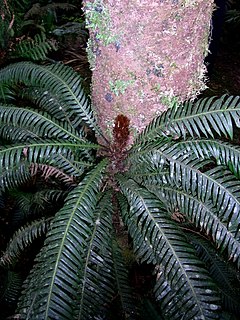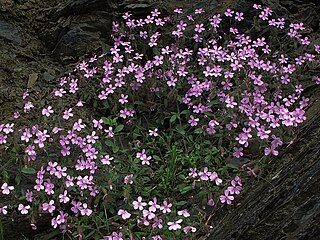
Dacrydium cupressinum, commonly known as rimu, is a large evergreen coniferous tree endemic to the forests of New Zealand. It is a member of the southern conifer group, the podocarps. The former name "red pine" has fallen out of common use.

Blechnum, known as hard fern, is a genus of ferns in the family Blechnaceae, subfamily Blechnoideae, according to the Pteridophyte Phylogeny Group classification of 2016. Two very different circumscriptions of the genus are used by different authors. In the PPG I system, based on Gasper et al. (2016), Blechnum is one of 18 genera in the subfamily Blechnoideae, and has about 30 species. Other sources use a very broadly defined Blechnum s.l., including accepting only two other genera in the subfamily. The genus then has about 250 species. In the PPG I circumscription, the genus is mostly neotropical, with a few southern African species.
Asplenium bifrons is a species of fern in the family Aspleniaceae. It is endemic to Ecuador. It is known only from one population in Pichincha Province. Its natural habitat is subtropical or tropical moist montane forests. It is threatened by habitat loss for hydroelectric power.
Parablechnum monomorphum, synonym Blechnum monomorphum is a species of fern in the family Blechnaceae. It is native to Colombia (Antioquia), Ecuador and Bolivia.
Blechnum petiolare is a species of fern in the family Blechnaceae. It is endemic to Ecuador and known only from Bolívar Province. When it was first described in the early 20th century, it was known from Chillanes but this area has been heavily disturbed and the species continues to be threatened.
Austroblechnum divergens, synonyms including Blechnum divergens, Blechnum rimbachii and Blechnum floresii, is a species of fern in the family Blechnaceae.
Blechnum sociale is a species of fern in the family Blechnaceae. It is endemic to Pichincha Province and Azuay Province, Ecuador, but has not been recorded since 1893. The name sociale indicates that they form in colonies. It was first described by Sodiro in 1883. In 1893, Sodiro transferred it to Lomaria as Lomaria socialis. He said that the most similar species was Lomaria stipitellata, now placed in Parablechnum as Parablechnum stipitellatum. The status and taxonomy of Blechnum sociale was unclear as of 2003.
Carex thouarsii is a species of sedge found in the Tristan da Cunha archipelago. It lives chiefly in heaths dominated by Blechnum palmiforme, and Phylica arborea woodland. It is widespread and common on Tristan da Cunha and Inaccessible Island, but scarce on Nightingale Island, possibly due to a lack of habitat. It was first described by Dugald Carmichael in 1819 following the British annexation of Tristan da Cunha in 1816.
Hymenophyllum nanum is a species of fern in the family Hymenophyllaceae. It is endemic to Ecuador, where it is known from two old collections in Pichincha Province. Its natural habitat is the forest of the lower Andes. It is threatened by habitat loss.
Phlegmariurus nutans, synonym Huperzia nutans, known as wawaeʻiole or nodding clubmoss, is a species of club moss in the family Lycopodiaceae. It is endemic to wet forests and cliffside shrublands on the islands of Oahu and Kauai in Hawaii. It is threatened by habitat loss.
Saccoloma laxum is a species of fern in the family Lindsaeaceae. It is endemic to Ecuador, where it is only known from a single location in Zamora-Chinchipe Province. It grows in Amazonian forest habitat on limestone, a rock type which is rare in the region. It is threatened by urbanization and deforestation.
Amauropelta subtilis, synonym Thelypteris subtilis, is a species of fern in the family Thelypteridaceae. It is endemic to Ecuador. It was found in the Andean forest. Its natural habitat is subtropical or tropical moist montane forests. It is threatened by habitat destruction, but apart from that, there are no other known threats.

Neoblechnum is a genus of ferns in the family Blechnaceae, subfamily Blechnoideae, with a single species Neoblechnum brasiliense, according to the Pteridophyte Phylogeny Group classification of 2016. The genus is accepted in a 2016 classification of the family Blechnaceae, but other sources sink it into a very broadly defined Blechnum, equivalent to the whole of the PPG I subfamily; the species is then known as Blechnum brasiliense. It is called Brazilian dwarf tree fern, red Brazilian tree fern, and red dwarf tree fern.

Lomariocycas tabularis, synonym Blechnum tabulare, known as the mountain blechnum is a large, attractive fern that is indigenous to sub-saharan Africa.

Lomaridium contiguum, synonym Blechnum contiguum, is a fern in the family Blechnaceae. The specific epithet refers to the contiguous lobes of the fronds.
Ctenitis pallatangana is a species of fern. The only known collection was made more than a century ago, near Pallatanga in Chimborazo province, Ecuador, in high Andean forest above 1 500 m altitude. Lack of any further collections and widespread destruction of its habitat has resulted in it being listed by the IUCN as "Critically Endangered ". The main threat to the species is believed to be habitat destruction by agricultural expansion.

Petrocoptis pseudoviscosa, commonly known as falguera, is a species of plant in the family Caryophyllaceae. It is endemic to the Spanish province of Huesca, where it is only known from the Valle del Ésera in the Pyrenees. Its natural habitat is calcareous cliffs, crags and caves.
Lomaridium is a genus of ferns in the family Blechnaceae, subfamily Blechnoideae, according to the Pteridophyte Phylogeny Group classification of 2016. The genus is accepted in a 2016 classification of the family Blechnaceae, but other sources sink it into a very broadly defined Blechnum, equivalent to the whole of the PPG I subfamily.
Cleistoblechnum is a genus of ferns in the family Blechnaceae, subfamily Blechnoideae, with a single species Cleistoblechnum eburneum, according to the Pteridophyte Phylogeny Group classification of 2016. The genus is accepted in a 2016 classification of the family Blechnaceae, but other sources sink it into a very broadly defined Blechnum, equivalent to the whole of the PPG I subfamily.

Cyrtandra heinrichii, known as ha'iwale or lava cyrtandra, is a perennial flowering plant in the family Gesneriaceae. It is found on the Hawaiian island of Kauai.







